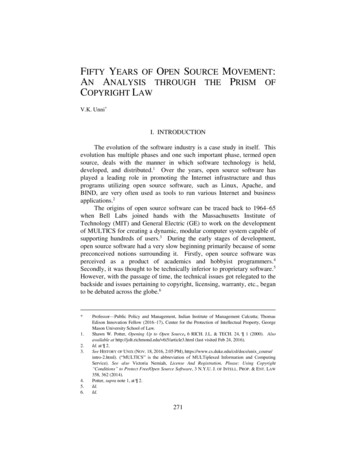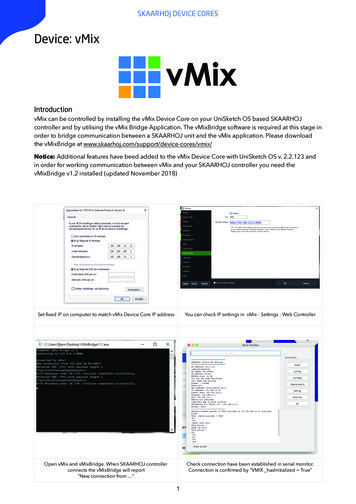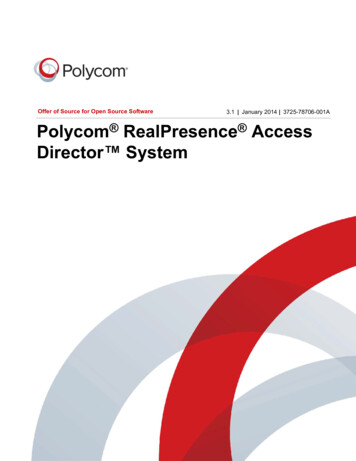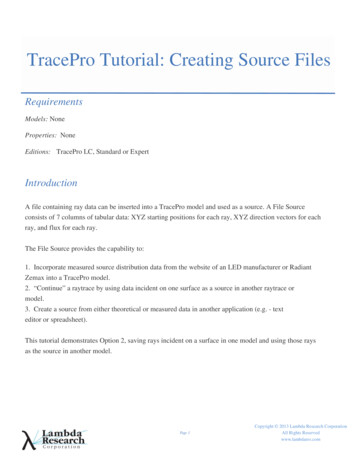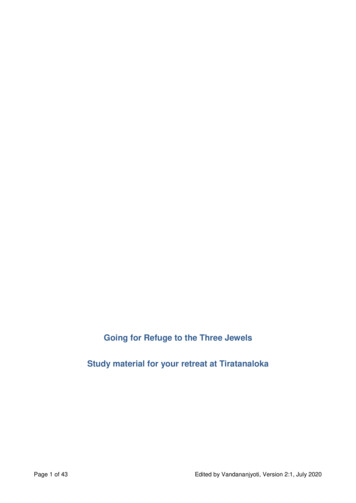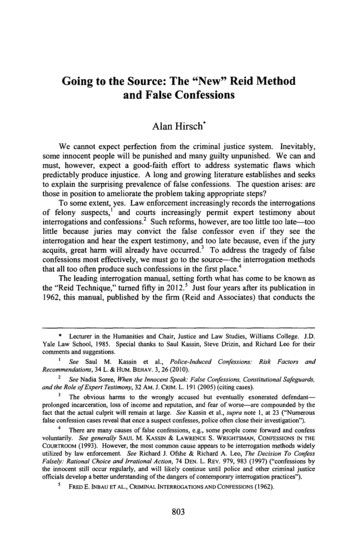
Transcription
Going to the Source: The "New" Reid Methodand False ConfessionsAlan Hirsch*We cannot expect perfection from the criminal justice system. Inevitably,some innocent people will be punished and many guilty unpunished. We can andmust, however, expect a good-faith effort to address systematic flaws whichpredictably produce injustice. A long and growing literature establishes and seeksto explain the surprising prevalence of false confessions. The question arises: arethose in position to ameliorate the problem taking appropriate steps?To some extent, yes. Law enforcement increasingly records the interrogationsof felony suspects,' and courts increasingly permit expert testimony aboutinterrogations and confessions. 2 Such reforms, however, are too little too late-toolittle because juries may convict the false confessor even if they see theinterrogation and hear the expert testimony, and too late because, even if the juryacquits, great harm will already have occurred. To address the tragedy of falseconfessions most effectively, we must go to the source-the interrogation methodsthat all too often produce such confessions in the first place.4The leading interrogation manual, setting forth what has come to be known asthe "Reid Technique," turned fifty in 2012.s Just four years after its publication in1962, this manual, published by the firm (Reid and Associates) that conducts the* Lecturer in the Humanities and Chair, Justice and Law Studies, Williams College. J.D.Yale Law School, 1985. Special thanks to Saul Kassin, Steve Drizin, and Richard Leo for theircomments and suggestions.1 See Saul M. Kassin et al., Police-Induced Confessions: Risk Factors andRecommendations, 34 L. & HUM. BEHAV. 3, 26 (2010).See Nadia Soree, When the Innocent Speak: False Confessions, ConstitutionalSafeguards,and the Role ofExpert Testimony, 32 AM. J. CRIM. L. 191 (2005) (citing cases).2The obvious harms to the wrongly accused but eventually exonerated defendantprolonged incarceration, loss of income and reputation, and fear of worse-are compounded by thefact that the actual culprit will remain at large. See Kassin et al., supra note 1, at 23 ("Numerousfalse confession cases reveal that once a suspect confesses, police often close their investigation").4 There are many causes of false confessions, e.g., some people come forward and confessvoluntarily.See generally SAUL M. KAssIN & LAWRENCE S. WRIGHTSMAN, CONFESSIONS IN THECOURTROOM (1993). However, the most common cause appears to be interrogation methods widelyutilized by law enforcement. See Richard J. Ofshe & Richard A. Leo, The Decision To ConfessFalsely: Rational Choice and IrrationalAction, 74 DEN. L. REv. 979, 983 (1997) ("confessions bythe innocent still occur regularly, and will likely continue until police and other criminal justiceofficials develop a better understanding of the dangers of contemporary interrogation practices").5FRED E. INBAU ET AL., CRIMINAL INTERROGATIONS AND CONFESSIONs (1962).803
804OHIO STATE JOURNAL OF CRIAINAL LAW[Vol 11:26most widely attended training sessions for interrogators, attracted scathingcommentary from the United States Supreme Court. In the seminal case ofMiranda v. Arizona,7 the Court crafted its famous warning to criminal suspects inlarge part to protect against the psychological coercion at the heart of the ReidTechnique.8 A year later, in 1967, Reid and Associates produced a second editionthat incorporated Miranda warnings into its course of instruction, even as theauthors brushed aside the Court's criticism.91986 brought forth a third edition of the manual, "an entirely new book"responsive to developments in the law governing confessions and interrogationsand to improvements in the "art of interrogation."10 Though there would berefinements in subsequent editions, the 1986 manual set forth the essentials of theReid Technique as we know it today. However, while expressing opposition to"any interrogation tactic or technique that is apt to make an innocent personconfess,"" the manual had little to say about the risk of false confessions.12 Theomission was understandable, as this edition pre-dated the work of the InnocenceProject, which awakened legal scholars and social scientists to the frequency offalse confessions and spurred intense inquiry into their causes.13Subsequently, Reid and Associates has produced two new editions of itsmanual, a fourth edition in 2001 and fifth in 2011, which include new material6 See FRED E. INBAU ET AL., CRIMINAL INTERROGATIONS AND CONFESSIONS viii (5th ed.2011) (stating that "the Reid Technique of Interviewing and Interrogation is now taught in seminarsacross the United States, Canada, Europe, and Asia" and "hundreds of thousands of investigatorshav[e] received this training.").Miranda v. Arizona, 384 U.S. 436 (1966).Id. at 457 ("It is obvious that such an interrogation environment is created for no purposeother than to subjugate the individual to the will of his examiner. This atmosphere carries its ownbadge of intimidation. To be sure, this is not physical intimidation, but it is equally destructive ofhuman dignity.").9 They opined that "[t]he Court's critical comments about the procedures we advocated were,we believe, for the purpose of establishing the necessity for the warnings rather than as acondemnation of the procedures themselves."JOHN E. REID ET AL., CRIMINAL INTERROGATIONS ANDCONFESSIONS I (2d ed. 1967). They added that if the Court disapproves of the Reid Technique, itwould have no choice but "to outlaw all interrogations of criminal suspects. We say this because ofour confidence that effective interrogations can only be conducted by such procedures as the ones weherein describe." Id10 FRED E. INBAU ET AL, CRIMINAL INTERROGATIONS AND CONFESSIONs v (3d ed. 1986)." Id. at xiv (emphasis in original).12 There were a few scattered references to the issue, e.g., "an interrogator should view withconsiderable skepticism any 'conscience-stricken' confession. Such a confession is very likely to befalse." Id. at 197.13 ions.php. (last visited Apr. 17, 2014) (as of July7, 2012, "[i]n about 25%" of the 292 cases of wrongful convictions established by DNA testing,"innocent defendants made incriminating statements, delivered outright confessions or pled guilty").
2014GOING TO THE SOURCE805ostensibly responsive to the increased concern about false confessions.1 4 Thisessay focuses on the adequacy of the response. It concludes that while in certainrespects Reid and Associates has made important concessions andaccommodations, in crucial respects it has ignored or distorted what has beenlearned about false confessions, thereby assuring that this disturbing phenomenonwill remain pervasive.I. THE REID METHOD EXPLAINED AND CRITIQUEDThe Reid Technique of interrogation is presented as a nine-step process, butthe various steps can usefully be reduced to three: isolation, confrontation, andminimization.15 The process begins by placing the suspect in a small, barelyfurnished room, apart from friends, family, familiar surroundings, or any supportsystem. This isolation increases the suspect's anxiety and eagerness to extricatehimself from the situation.The interrogation itself typically begins with an accusation of the suspect,buttressed by the suggestion that the interrogators have irrefutable evidence,sometimes fabricated.' 6 Denials of guilt are aggressively cut off. The idea is tocommunicate to the suspect the futility of maintaining innocence. Subsequently,the interrogators seek to minimize the nature or consequences of the crime.Minimization themes, which include (but are not limited to) accident, justification,provocation, mitigating circumstances, and secondary role, lead the suspect to inferthat he will be treated leniently if only he confesses. Confrontation brings ondespair; minimization supplies a lifeline. Together, they break down manysuspects.The problem is that these tactics are too powerful, i.e., can break down theinnocent as well as the guilty. Evidence that the Reid Technique breaks down14 John Reid passed away in 1982, and his original collaborator, Fred Inbau,passed away in1998. The lead authors of the fourth and fifth editions are Joseph Buckley, who also assisted with thethird edition, and Brian Jayne. For the sake of convenience, I shall use "Reid authors" throughoutthis essay to denote authors of all editions of the Reid Manual.15 The full nine steps are: Step 1-Direct, positive confrontation.Step 2-Themedevelopment. Step 3-Handling denials to get a confession. Step 4-Overcoming objections. Step5-Procurement and retention of suspect's attention. Step 6-Handling the suspect's passive mood.Step 7-Presenting an alternative question. Step 8-Having the suspect orally relate various detailsof the offense. Step 9-Converting an oral confession into a written confession. INBAU, supra note6, at 185-328.16 The Reid Manual takes a somewhat elliptical approach to confrontingsuspects with claimsof evidence that does not actually exist. At one point it states, with seeming approval, that "[i]n somecases, an investigator may falsely imply, or outright state, that evidence exists that links the suspect tothe crime," id. at 351, and the authors observe that "[i]t is our clear position that merely introducingfictitious evidence during an interrogation wouldn't cause an innocent person to confess." Id. at 352.For tactical reasons, however, they advise "great caution" in making such claims, id. at 42, at onepoint suggesting it only as a "last resort effort," id. at 352, both because courts may look askance atsuch tactics, and the interrogator risks losing credibility in the eyes of the suspect.
806OHIO STATE JOURNAL OF CRIMINAL LAW[Vol 11:2innocent suspects is threefold. First, as an empirical matter, we find thesemeasures utilized in many cases of proven false confessions." Second, we findthis effect reproduced in laboratory studies.' 8 Third, social scientists haveexplicated how, applying basic principles of decision-making, we should expectthe Reid Technique to produce false confessions, i.e., this seeminglycounterintuitive phenomenon makes perfect sense once we understand themethod's basic workings.19 After all, the very purpose of the Reid Technique is toput the suspect in an untenable situation where confession appears to be the onlymeans of escape.20It might seem obvious that the confrontation/minimization combination,employed by authority figures on an isolated and powerless individual, risksbreaking down the innocent as well as the guilty. 2 1 Yet the purveyors of the Reid" See Steven A. Drizin & Richard A. Leo, The Problem of False Confessions in the PostDNA World, 82 N.C. L. REV. 891 (2004).18 In the seminal study, college students were instructed to type on a desktop computer butwarned that the Alt key was off limits, as hitting it would cause the computer to crash. Saul M.Kassin & Katherine Kiechel, The Social Psychology of False Confessions: Compliance,Internalizationand Confabulation, 7 PSYCHOL. SCI. 125 (1996). Subsequently, each subject was toldthat the computer had crashed and was accused, falsely, of having hit the Alt key. All studentsdenied their guilt. But when a confederate of the experimenter confronted the suspect with the claimthat she witnessed them hitting the forbidden key, many of the students acknowledged guilt andsigned a written confession. Interviews afterward revealed that some of these students actually cameto believe they were responsible; some even concocted details of how they hit the Alt key. Onelimitation of this study is that the participants faced no penalty for confessing. However, subsequentstudies replicated the effects even when the subjects were told that they would be fined or otherwisepunished for hitting the prohibited key. See Robert Horselenberg et al., IndividualDiferences andFalse Confessions: A Conceptual Replication of Kassin and Kiechel, 9 PSYCHOL. CIM. & L. 1(2003); Allison Redlich & Gail Goodman, Taking Responsibility for an Act Not Committed: TheInfluence ofAge and Suggestibility, 27 L. & HuM. BEHAV. 141 (2003).A different experiment concerns the risks of minimization. People were assigned tasks in pairsbut also given tasks they were supposed to do alone. Subjects were then accused of havingimpermissibly cooperated-in effect, cheating. Most of them denied guilt. But interrogatorsintroduced minimization themes to some of the subjects, implying that their offense was not so bad,and they might not be punished severely if they confessed. Within this group, the false confessionrate tripled. See Melissa Russano et al., Investigating True and False Confessions Within a NovelExperimentalParadigm, 16 PSYCHOL. Sci. 481, 484 (2005).19 See Ofshe & Leo, supra note 4, at 983 (1997) ("[P]olice-induced false confessions, liketruthful ones, are rational responses to the influence tactics and manipulation strategies that Americanpolice use during interrogation.").20 There is another category of false confessions where the suspect actually comes to believein his own guilt, or at least to regard it as possible. The "internalized false confession" is discussedinfra, see text accompanying notes 31-35.21 I have elsewhere noted (and tried to explain) the irony that in fact the risks used to berecognized as obvious-which is why, in the nineteenth century, the Supreme Court banned theadmissibility of confessions that followed even the slightest or most indirect threats or minimization.See Alan Hirsch, Threats, Promises, and False Confessions: Lessons of Slavery, 49 How. L.J. 31, 32("Though it may seem odd, the judicial system has taken a huge step backwards from the NineteenthCentury" in safeguarding against false confessions.).
2014GOING TO THE SOURCE807Technique clearly did not envision this result-no servants of law enforcementwould endorse a method that predictably endangers the innocent.22 How, then,could Reid and Associates be confident that its method does not, in fact, breakdown innocent as well as guilty suspects?The answer emerges from a careful reading of the Reid Manual. Perhaps thesingle most important sentence of the 450 page manual occurs near the outset-infull italics, suggesting the authors' recognition of its significance: "Aninterrogation is conducted only when the investigator is reasonably certain of thesuspect's guilt."23 Later, in the course of describing the confrontational nature of atypical interrogation, the authors see fit to reiterate this key point: interrogationtechniques are confined to situations "where the suspect's guilt seems to theinvestigator to be definite or reasonably certain."24 Or, as one of the authors told askeptical questioner at a conference, he does not worry about eliciting confessionsfrom the innocent because "we do not interrogate innocent people." 25How do Reid-trained interrogators assess guilt prior to an interrogation? Insome cases, they do so through the investigatory process, gathering evidence thatobjectively establishes guilt. Of course, in such cases a confession, whilewelcome, is less important. But Reid-trained investigators learn that in most casesthe onerous fact-gathering process can be side-stepped. The assessment ofinnocence and guilt can instead be made in the course of a non-accusatoryinterview, during which the interrogator sizes up the suspect's body language andresponse to verbal cues. In fact, the Reid Manual devotes almost as much space tothis pre-interrogation interview process, which determines whether the intervieweewill subsequently be interrogated, as to the actual interrogation process itself. Asthe authors state, where evidence is lacking, "conducting a nonaccusatory [preinterrogation] interview of the suspect is indispensible with respect to identifyingwhether the suspect is, in fact, likely to be guilty." 26Unfortunately, this crucial aspect of the Reid approach fails to survivescrutiny. Study after study establishes that humans, trained interrogators included,22 Indeed, seeking to remove any doubt on this point, the Reid authorssee fit to clarify that"we are opposed to the use of any interrogation tactic or technique that is apt to make an innocentperson confess." INBAU, supra note 6, at xi. Such a statement was present as early as the thirdedition in 1986, see INBAU, supra note 10.2324INBAU supra note 6, at 5.Id. at 201.25Saul M. Kassin & Gisli Gudjonsson, The Psychology of Confessions; A Reviewof theLiterature andIssues, 5 PSYCHOL. SCI. PuB. INT. 33, 36 (2004).26INBAU, supra note 6, at 6.
808OHIO STATE JOURNAL OF CRIMINAL LAW[Vol 11:2are poor lie detectors. 27 No one, or virtually no one, can determine a person's guiltthrough the interviewing process at the heart of the Reid approach.2 8The propensity of the Reid Technique to cause false confessions followsinexorably from the two points developed above: detectives determine whom tointerrogate based on a deeply flawed screening process,29 then subject those whoslip through the screen (that is, those wrongly betrayed by their body language orverbal responses) to an interrogation potent at overcoming resistance byconvincing people they are better off confessing.The above is sufficiently well established as to command near unanimity fromthose conversant with the relevant literature developed over the last few decades.30And Reid and Associates, in the newer editions of its manual, has offered at leastsomewhat of a response to these discomfiting truths. The 2001 edition included alengthy new chapter, "Distinguishing between True and False Confessions," andthe 2011 edition added material to that chapter. Both the 2001 and 2011 editionsalso added important material to a chapter on "Behavior Symptom Analysis"-themethods used to screen out the innocent in the pre-interrogation interview.To determine the adequacy of these additions to meet the problem of falseconfessions, we shall look primarily at the most recent and comprehensive editionof the Reid Manual, the fifth edition published in 2011. Do the authors candidlyacknowledge the scope of the problem of false confessions? Do they recommendmeasures that substantially ameliorate the problem?II. CONCESSIONS AND ACCOMMODATIONSIn at least four respects, the Reid authors deserve credit for learning from theconfessions literature and making appropriate adjustments. First, the authors makeuseful recommendations to prevent the "internalized false confession," where a27 See, e.g., Christian Meissner & Saul M. Kassin, "He's Guilty!": Investigator Bias inJudgments of Truth and Deception, 26 L. & HUM. BEHAV. 469, 470 (2002) (citing and summarizingstudies).28 One study suggests that the occasional very rare person does indeed possess the power todetect lies. In this study, the researchers tested over 20,000 individuals' ability to detect lies andfound that 50 (or .25%) had an accuracy rate of 80% or higher. Maureen O'Sullivan & Paul Ekman,The Wizards ofDeception Detection, in DECEPTION DETECTION INFORENSIC CONTEXTS 269 (Granhag& Stromwall eds. 2004). The issue of behavior symptom analysis is discussed in much greater detailinfra, notes 77-84 and accompanying text.29 See Richard A. Leo & Stephen Drizin, The Three Errors: Pathways to False Confessionand Wrongful Conviction, in POLICE INTERROGATIONS AND FALSE CONFESSIONs 12 (Lassiter &Meissner eds., 2010) (The path to false confession begins when "investigators first misclassify aninnocent person as guilty.").30 The qualification is necessary because of a few high-profile skeptics. See, e.g., PaulCassell, The Guilty and the Innocent: An Examination of Alleged Cases of False Confessions ofWrongful Convictionfrom False Confessions, 22 HARv. J.L. & PUB. PoL'y 526 (1999).
2014GOING TO THE SOURCE809person confronted with allegedly objective evidence of his guilt actually comes tobelieve he committed the crime. 3'To be sure, the manual commences its discussion of this counterintuitivephenomenon with skepticism, 32 and its later claim that the internalized falseconfession phenomenon is "not implausible" seems unnecessarily grudging givenNevertheless, the authorsthat quite a few such cases have been documented.propose that, when confronted with a suspect distrustful of his memory, "theinvestigator must be certain not to . . suggest that the suspect committed the crimeeven if he has no recollection of doing so. . [A]t no time should an investigatorattempt to persuade a suspect that he is guilty of a crime he claims not to remembercommitting." 34 Further, they admonish interrogators not to confront such a suspectclaiming to have evidence against him that they do not in fact have. 35Unfortunately, the Reid authors' commendable effort to prevent internalizedfalse confessions may not go far enough. They warn against expressing certaintyof guilt and introducing false evidence after a suspect claims not to remembercommitting the crime. But internalized false confessors may exhibit no uncertaintyof memory until they are confronted with false evidence. 36 Nevertheless, therecommended prophylactic measures are at least steps in the right direction.Another step in the right direction stems from recognition that certainpopulations-particularly juveniles and those with diminished mental capacity orsuffering from mental illness-are especially prone to false confessions. The Reidauthors recommend that such groups be spared the more aggressive aspects of the31 For the leading analysis of this phenomenon, see Saul M. Kassin, Internalized FalseConfessions, in 1 HANDBOOK OF EYEWITNESS PSYCHOLOGY 175 (Toglia, Read, Ross, & Lindsay, eds.,2007).32 See INBAU, supra note 6, at 341-42 ("A claim that a confession was coerced internalized isan inviting defense for a guilty defendant who chooses to retract his confession . . [A]ll a defendanthas to do, when claiming a coerced internalized confession, is take the position that he believed hewas guilty of the crime at the time of the confession.").33 See Kassin, supra note 31, at 181-82.34 See INBAU, supra note 6, at 350-51.35 Id. at 352. Indeed, the introduction of false evidence seems to trigger most internalizedfalse confessions, such as the well-publicized case of Marty Tankleff. In a state of shock after havingdiscovered his parents' brutalized corpses, Tankleff was told (falsely) by the police that his father, ina dying declaration, declared his son the culprit. Concluding that he must have committed the crimeand blacked out, Tankleff confessed. His conviction was later reversed under circumstances leavinglittle doubt as to his innocence, and the government did not retry him. See Bruce Lambert, No Retrialin'88 Double Killing onLong Island, N.Y.TIMES,(July1, 1tankleff.html?r-0.36 See Kassin, supra note 31, at 181.
8 10OHIOSTATE JOURNAL OF CRIMINAL LAW[Vol 11:2Reid Technique.If that admonition is followed, the prevalence of falseconfessions will surely be reduced.38To their credit, in the fourth and fifth editions of their manual, the Reidauthors also emphasize the importance of corroborating confessions and thesuspicious nature of confessions that remain uncorroborated. 3 9 They correctly notethat "the best type of corroboration is in the form of new evidence that was notknown before the confession." 4 0 Related, but even more important, the authorsinsist that "[w]hen developing corroborative information, the investigator must becertain that the details were not somehow revealed to the suspect through thequestioning process, news media, or the viewing of crime scene photographs."4'This admonition is most welcome in light of the frequent failure of interrogators tofollow such a course. In many cases of proven false confessions, the interrogatorsapparently supplied the suspect details of the-crime.42Finally, the Reid authors endorse the electronic recording of interrogations,43a measure enthusiastically promoted by most reformers in this area andincreasingly embraced by law enforcement. 4 To their credit, they note that theidea of mandatory recording was "not embraced with open arms by the lawenforcement community" but that concerns proved unwarranted.45With respect to each of the issues discussed in this section, Reid andAssociates is now in substantial agreement with its long-time critics, a noteworthydevelopment.46 In several other areas, however, sharp disagreement persists,beginning with the very purpose of the Reid Technique.338INBAU, supra note 6, at 352-54.3940INBAU, supra note 6, at 354-60.Id. at 306.41idSee Drizin & Leo, supra note 17, at 944 (in study of proven false confessions, almost onethird were juveniles, and almost one-third were either mentally retarded or suffered from mentalillness).42 See Brandon Garrett, The Substance ofFalse Confessions, 62 STAN. L. REv. 1051 (2010).43INBAU, supra note 6, at 325.4See Brian Jayne, Empirical Experiences of Required Electronic Recording of Interviewsand Interrogationson Investigators'Practicesand Case Outcomes, 4 LAw ENFORCEMENT EXECUTIVEFORUM 103 (2003) (in survey of investigators in Alaska and Minnesota, which require recording,85% supported the law or said their interrogations were unaffected by it); Kassin et al., supra note 1,at 25 (electronic recording of confessions has "drawn advocates from a wide and diverse range ofprofessional, ideological, and political perspectives"). Recorded interrogations put judges (insuppression hearings and bench trials) and juries in better position to consider the interrogativepressures applied to a suspect, to evaluate whether details in the confession may have been supplied,and to resolve factual disputes over exactly what transpired prior to the confession. In addition, apolicy of recording can deter interrogative excesses.45INBAU, supra note 6, at 50.46 Another important area of potential agreement, the need to avoid lengthy interrogations, isdifficult to assess because of the Reid Manual's vagueness. Data establish a correlation between thelength of interrogations and risk of false confessions; in 84% of false confessions the interrogation
GOING TO THE SOURCE20148 11III. DENIALA. Frequency ofFalse ConfessionsIn assessing the adequacy of the new material in the latest editions of the ReidManual, one crucial threshold question concerns the extent to which the authorsacknowledge the underlying problem. Notwithstanding their endorsement ofcertain reforms, they are unlikely to craft meaningful changes in their approachunless they consider the problem of false confessions sufficiently widespread as towarrant a serious response.Near the outset of their new chapter on false confessions (added in the fourthedition and revised in the fifth), the authors address that issue directly: "There is noquestion that interrogations have resulted in false confessions from innocentsuspects.However, . . . [e]ven critics of police interrogation agree that mostconfessions are true."47 This statement sets the bar absurdly low. Of course mostconfessions are true. It is horrifying to imagine a regime of law enforcement thatproduced mostly false confessions. But are the critics of the Reid Techniquecorrect to maintain that false confessions are surprisingly prevalent? The Reidauthors dismiss that possibility, declaring toward the end of the chapter on falseconfessions that "the research findings presented in this chapter reveals that falseconfessions do occur but that they are rare occurrences."48However, the basis of this conclusion is unclear. The chapter's only"findings" with respect to the frequency of false confessions are references tooutdated or irrelevant works. Drawing on an oft-cited 1987 study by Hugo Bedauand Michael Redelet of wrongful convictionS49 (not limited to cases involvingconfessions), the Reid authors note forty-nine "possible false confession[s]." 5 0Later, they cite the "60 possible false confessions" identified by Professors RichardOfshe and Richard Leo in a 1998 essay. 5' But Professors Bedau and Radelet wereexceeded six hours. See Drizin & Leo, supra note 17. The Reid Manual says virtually nothing aboutthe appropriate length of interrogations, but a few comments are potentially significant: "A properlyconducted interrogation that lasts 3 or 4 hours, for the ordinary suspect, is certainly not so long as tocause the levels of emotional or physical distress that constitute duress," but "[a] suspect who hasmaintained his innocence and made no incriminating statements for 8 or 10 hours has not offered anybehavior to account for this lengthy period of interrogation." INBAU, supra note 6, at 347, 348. Tothe extent these statements together can be read as suggesting that interrogations should rarely exceedfour hours, and almost never reach eight, they represent welcome cautions.47Id. at 339.48 Id. at 367.49 Hugo Bedau & Michael Radelet, Miscarriageof Justice in Potentially Capital Cases, 40STAN. L. REv. 21 (1987).50 INBAU, supra note 6, at 340.51 Id. at 363, citing Richard Ofshe & Richard Leo, The Consequences of False Confessions:Deprivations of Liberty and Miscarriagesof Justice in the Age of PsychologicalInterrogation,88 J.CluM. L. & CRIMINOLOGY 429 (1998).
8 12OHIO STATE JOURNAL OF CRIMINAL LAW[Vol 11:2studying only capital cases-not to mention doing so a quarter century ago. TheOfshe/Leo article is also more than a decade old.The Reid authors also mention a 1996 observational study of 182interrogations by three police departments and declare that "not a single falseconfession was reported." 52 But this study made no effort to identify true or falseconfessions. Its purpose was entirely different: to identify what interrogationtechniques law enforcement utilizes in practice.Inexplicably, the Reid authors ignore much more recent and relevant data,particularly the most important empirical study of false confessions--one byProfessors Richard Leo and Steven Drizin published in 2004 that identifi
predictably produce injustice. A long and growing literature establishes and seeks to explain the surprising prevalence of false confessions. The question arises: are those in position to ameliorate the problem taking appropriate steps? To some extent, yes. Law enforcement increasingly records the interrogations




